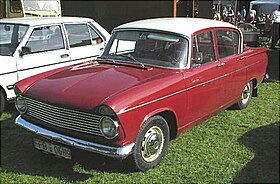Hillman Super Minx
| Hillman Super Minx | |
|---|---|

Hillman Super Minx Mk I
|
|
| Overview | |
| Manufacturer | Hillman (Rootes Group) |
| Also called | Humber 90 (New Zealand, South Africa) |
| Production | 1961–66 (saloon) 1962–64 (convertible) 1962–67 (estate) |
| Assembly | United Kingdom Port Melbourne, Australia Petone, New Zealand |
| Body and chassis | |
| Body style | Convertible |
| Related |
Singer Vogue Humber Vogue (Australia) Humber Sceptre Hillman Minx |
| Powertrain | |
| Engine | 1,592 cc (97.1 cu in) I4 (1961–65) 1,725 cc (105.3 cu in) I4(1965–67) |
| Dimensions | |
| Wheelbase | 101 in (2,565 mm) |
| Length | 165 in (4,191 mm)) |
| Width | 62.8 in (1,595 mm) |
| Height | 58 in (1,473 mm) |
| Curb weight | 2,239 lb (1,016 kg) (saloon) 2,368 lb (1,074 kg) (estate) |
| Chronology | |
| Successor | Rootes Arrow |
4-door saloon
5-door estate
2-door
The Hillman Super Minx is a family car which was produced by Hillman from 1961 to 1967. It was a slightly larger version of the Hillman Minx, from the period when the long-running Minx nameplate was applied to the "Audax" series of designs. (The Minx underwent many changes throughout its history, and the Super Minx name was not used during production of non-Audax Minx designs.)
Announced in October 1961, the Super Minx gave Rootes, and particularly its Hillman marque, an expanded presence in the upper reaches of the family car market. It has been suggested that the Super Minx design was originally intended to replace, and not merely to supplement, the standard Minx, but was found to be too big for that purpose. An estate car joined the range in May 1962, and a two-door convertible in June 1962. The convertible never sold in significant numbers: the last one was made in June 1964, ahead of the introduction, in September 1964, of the Super Minx Mark III.
The car was powered by the Rootes 1,592 cc (97.1 cu in) unit, which had first appeared late in 1953 with a 1,390 cc (85 cu in) capacity. The original Super Minx had the cast-iron cylinder head version of the engine, though on later cars the cylinder head was replaced with an aluminium one.
Suspension was independent at the front using coil springs with anti-roll bar and at the rear had leaf springs and a live axle. Un-assisted 9 in (229 mm) Lockheed drum brakes were fitted. The steering used a recirculating ball system and was as usual at the time not power assisted. Standard seating, trimmed in Vynide, used a bench type at the front with individual seats as an option. A heater was fitted but a radio remained optional. The car could be ordered in single colour or two tone paint. The four-speed manual transmission featured synchromesh on the top three ratios from the start and had a floor lever: "Smiths Easidrive" automatic transmission was option.
A car was tested by the British magazine The Motor in 1962 and had a top speed of 80.0 mph (128.7 km/h) and could accelerate from 0-60 mph (97 km/h) in 21.6 seconds. A "touring" fuel consumption of 27.9 miles per imperial gallon (10.1 L/100 km; 23.2 mpg‑US) was recorded. The test car cost £854 including taxes, which was then slightly less than the recently upgraded Austin Cambridge A60.
...
Wikipedia
